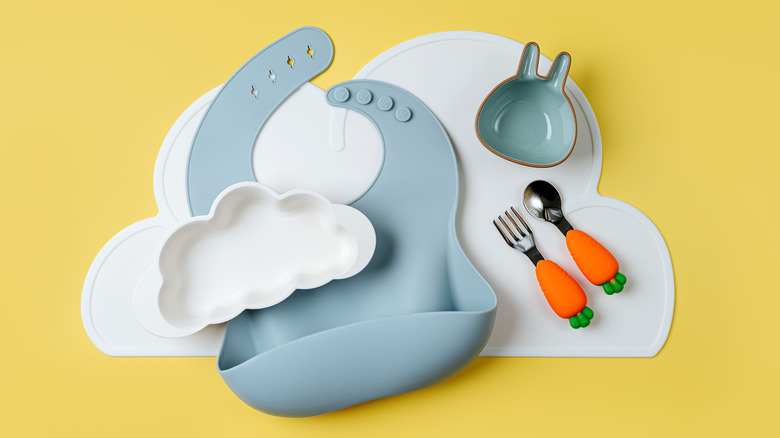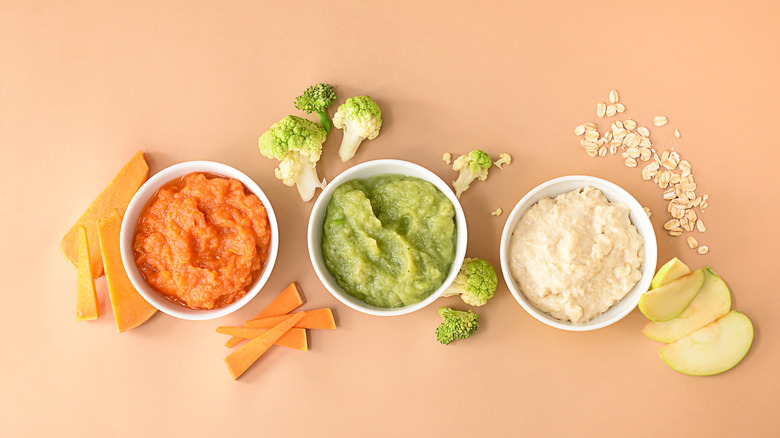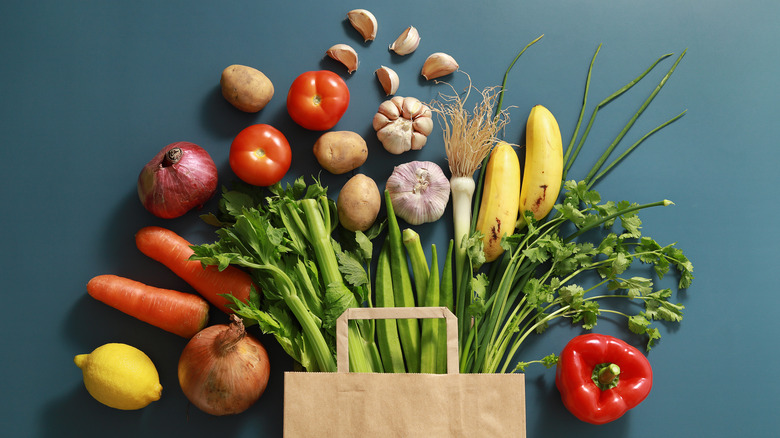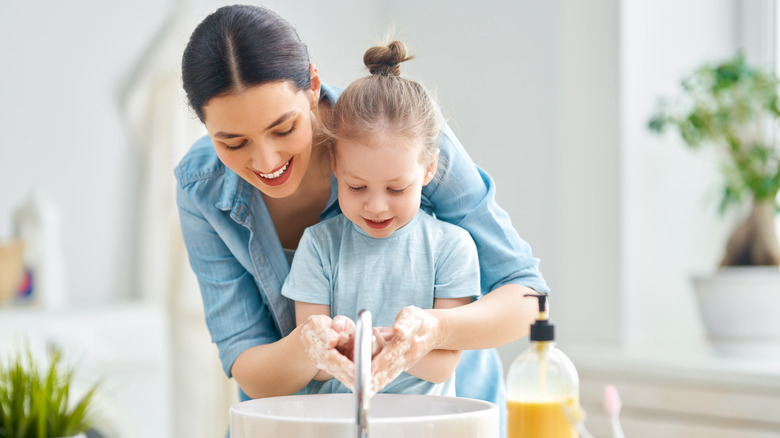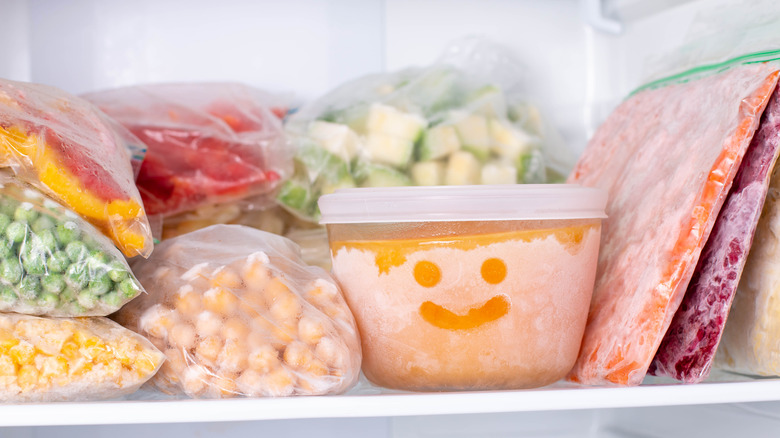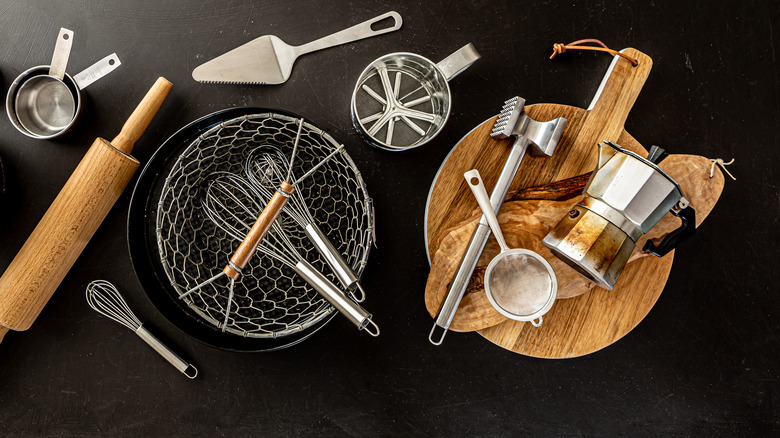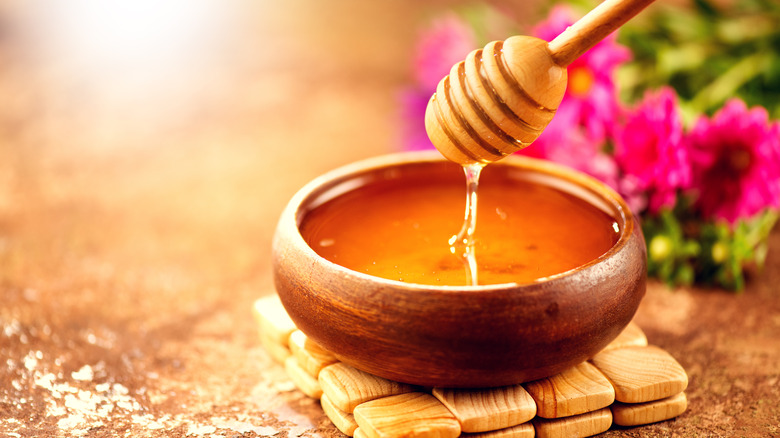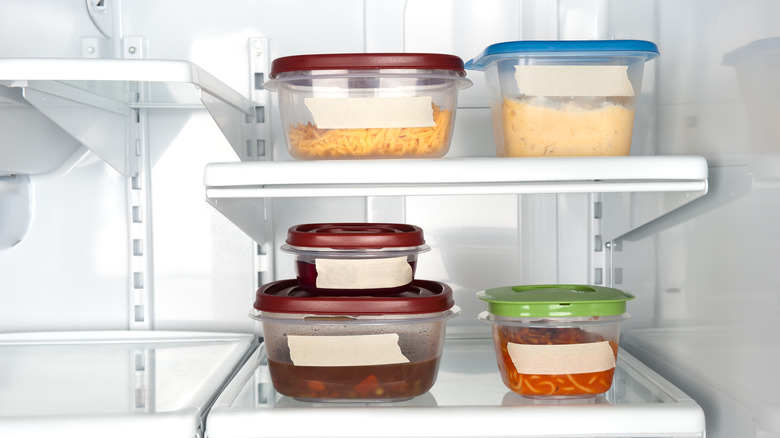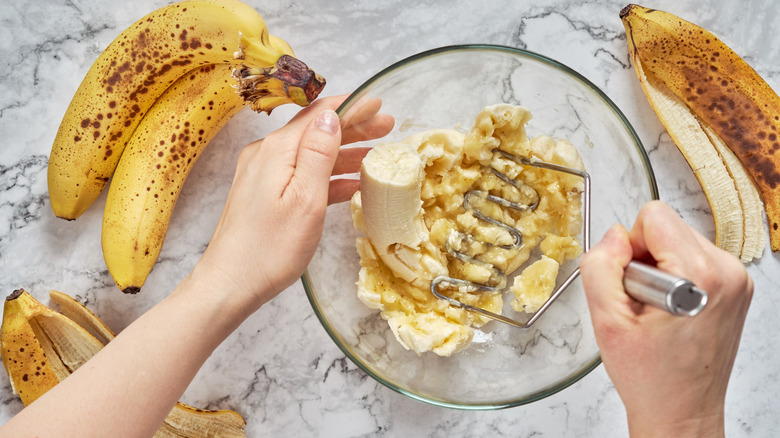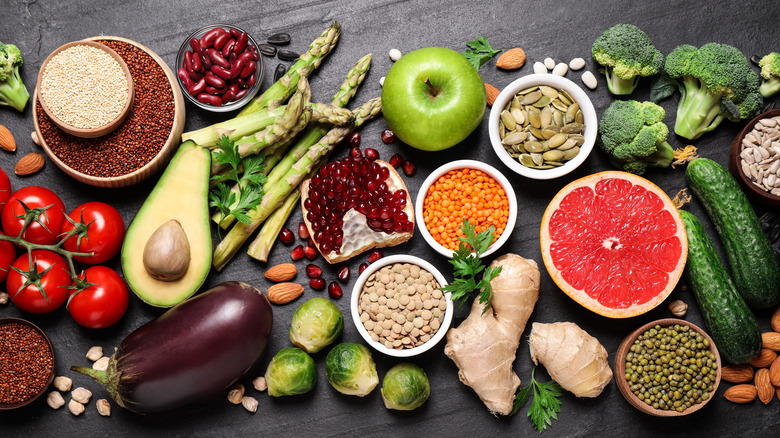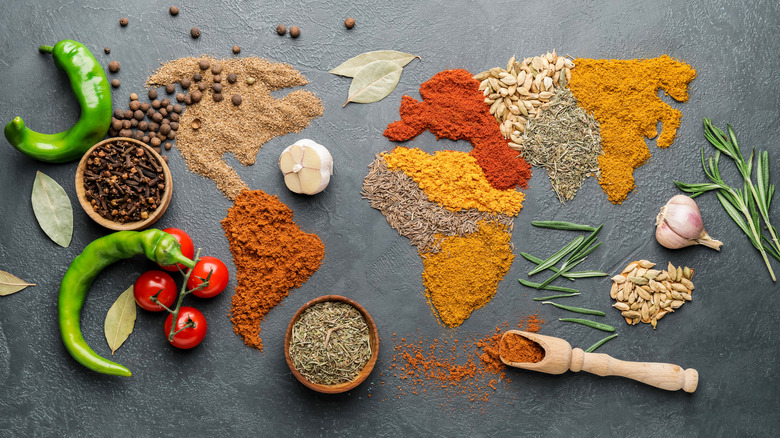Mistakes Everyone Makes When Making Homemade Baby Food
Being a new parent is a hard enough job without worrying about everyone else's opinions on baby food. And as the adage says, fed is best. Choosing how to feed your baby is a personal choice, and it can be challenging to wade through all the available options.
That said, if you've decided you want to skip the store-bought purees and make your own baby food, we're here to help. Making your own homemade baby food isn't hard to do once you've gotten the lay of the land, but there are quite a few common mistakes that everyone makes when starting out. We're here to take one thing off your to-do list by compiling all the information you need to get the process right. So stop stressing about which foods are safe, or how long you can store the puree you just made — we've got the answers to your burning questions so you can avoid baby food-making pitfalls and keep your little bit happy and well-fed.
Making too much food
We're all guilty of this. We're hungry ... so hungry we can't see straight, and when we're finally able to make time for a meal, we make a plate of food so big we can't begin to eat it all. The same is true when we're preparing food for babies. The baby is crying, you know they need to be fed, but it can be hard to judge how much food you need to prepare, especially since children's appetites change rapidly as they grow. Let us assure you that when babies are young, they need very little in the way of solid food or purees.
According to Raising Children, when babies first start eating solid foods, typically around six months old, you only need to offer about 1-2 teaspoons of food, once per day. At this stage, babies are generally only tasting the food and aren't consuming the food for its nutrients, which come primarily from breast milk or formula.
As the baby grows, you can increase their food consumption as their interest level and appetite grows, and by 12 months, most babies will consume three small meals per day. Given how little babies actually need in this early phase of life, make sure you're not preparing vats of baby food, as it will only go to waste.
Using too much liquid
A common issue with homemade baby food is that it can turn out runnier than expected. When you buy baby food at the grocery store, it's been processed in such a way as to ensure a scoopable consistency. However, many factors come into play at home that can lead to extra watery purees. For instance, the natural water content found in foods, such as fruits and vegetables like squash, are common culprits. Additionally, even if a food has a good consistency when prepared initially, there's no guarantee it will keep the same texture after being stored. Freezing, in particular, can cause liquid to separate and further break down the foods, leading to a watery puree (via Wholesome Baby Food).
So you've got a screaming baby in their highchair, and you've just pulled out your baby's dinner only to discover it is more soup than solid. What can you do about it? Thankfully, there is a quick solution: add a thickening agent to the food. Baby cereal is an excellent option for this, as it is very finely ground, can be added directly into your puree, and doesn't need to be cooked. For those who prefer not to use baby cereal, foods such as yogurt, mashed bananas, or smashed lentils can be used as a quick thickener as well.
Not cleaning the fruits and veggies
We are all guilty of this one at one time or another. You have a beautiful piece of fruit from the store or garden, and it looks clean enough, so you go ahead and take a bite. We all know that stuff tastes best pulled straight off the vine anyway, so what's the big deal? For babies, a lot.
The Center for Disease Control and Prevention reminds us that fresh fruits and vegetables can harbor harmful bacteria that the human eye can't see. Germs such as Salmonella, E. coli, and Listeria can be lurking on the surface of that beautiful fresh produce. These germs are harmful to kids and adults alike, and can be especially harmful to children under 5 years old.
To combat this, the CDC recommends that before consuming any fruit, wash the fruit under water, even if you don't intend to eat the skin or peel. While thinking about harmful bacteria might seem scary and make you think you should use something more powerful, the CDC says explicitly not to use any additional soaps. If you are worried and want an extra level of prevention, you can cook the fruit after it is washed. This will kill any residual germs.
Not washing your hands
Washing your hands before preparing your baby's food is just as important as washing the fruits and vegetables before using them. Kids are tiny germ magnets — they don't need any help from us to be exposed to more germs. The Center for Disease Control and Prevention reminds us that even something as simple as touching your face can spread germs. Therefore, it's vital to follow proper handwashing procedures before preparing baby food or feeding food to a baby.
There are five steps to properly washing hands. First, wet your hands under running water. Next, apply soap and lather. Make sure the hard to reach places, like the under the nail beds, are getting scrubbed with soap. Continue scrubbing for 20 seconds, or roughly the time it takes to sing Happy Birthday. Finally, rinse and dry your hands.
If no sink is available, hand sanitizer can be used to ensure no germs are spread to your baby's food.
Storing the food incorrectly
Baby food storage can be overwhelming. There are so many options and rules that it can be hard to keep everything straight. However, we all know proper food storage is an essential part of food safety, so we are here to give you the rundown on how to do it properly.
Food that has been freshly cooked should be placed in the refrigerator as soon as possible after cooking. It is a common myth that you can't put warm food into the refrigerator. The truth is, to avoid food spoilage, the food should be placed in the fridge within two hours of being cooked. Once in the refrigerator, baby food only lasts two to three days.
Freezing is a good option if you want the food to last longer than that. Healthy Little Foodies recommends using a flexible ice cube tray so that foods can be portioned out into individual servings. Portioning the food will make things much easier down the road. While some people think frozen food is a lesser form of food preservation, freezing food can actually help it retain higher values of nutrients and preserve quality better than other methods (according to the University of Minnesota Extension.)
Using less than clean utensils
Young babies are particularly susceptible to diseases. This susceptibility is why babies under three months or with special needs should have their feeding implements sterilized at least once a day, according to the Center for Disease Control and Prevention. While babies who are old enough to consume food might not need that level of sterilization, it is good practice to sterilize cooking and serving utensils once a week. Sterilizing is more than just doing a regular wash with soap and water. Sterilizing typically uses high heat to kill any residual germs, so those germs don't get transferred to the food the next time they are used.
If you have a dishwasher with a heat drying setting or sanitizing setting, congratulations! Just pop your machine washable equipment in and turn it on. No other steps are necessary. For those without a dishwasher, the CDC recommends three different sterilization methods. The first is to place the item in boiling water for five minutes. If you'd rather not do this, another way would be to get a plug-in sterilizer that uses steam, or to purchase sterilizing microwave bags. Finally, a diluted bleach solution can be used for items that can't be heated.
The Food and Drug Administration also make special note to remember to sterilize appliances, such as blenders or can openers, used to prepare baby food.
Using honey
Honey is a great way to add a natural sweetness to foods, especially if you are trying to avoid refined white sugar. But unfortunately, it should absolutely not be given to babies and should not be in any food intended for a baby under a year old. This seemingly strict rule is because honey carries with it the risk of botulism for infants.
The Mayo Clinic goes to great lengths to express the potential dangers of botulism in infants under a year of age. The bacteria that cause infant botulism is primarily found in dust, dirt, and honey. Raw honey is seen as one of the biggest threats of botulism for infants and should not be given to babies, even in small amounts. Kids Health goes so far as to recommend that parents not even give babies any processed foods containing honey, such as honey graham crackers, to help prevent the disease. So make sure to check the packaging of any foods you are cooking with and intend to feed your baby to ensure honey isn't slipping in under the radar.
Using leftovers to make baby food
Remember how we were so insistent that you not make too much baby food? Well, there was a good reason for that. Leftovers cannot be used again to make baby food. By this, we mean food that has touched the plate or utensil that the baby was eating with. The germs from your baby's mouth are transferred to the spoon and container, and this can cause unwanted bacteria to grow (according to the Food and Drug Administration). As discussed, babies typically don't eat very much, so make sure you are doling out small potions into a bowl so you can throw away the excess without feeling guilty.
Additionally, as Healthy Little Foodies points out, food that has been thawed should not be refrozen. This means that if you thaw out an entire container of baby food, even if you only used a small portion of it, the rest has to go in the fridge and now has to be used within the food safety parameters of the refrigerator. This is an additional reason why freezing baby food in small portions can save you heartache down the road, as no one wants to waste food.
Not watching expiration dates
Expiration dates are shrouded in mystery. As anyone who buys food knows, there seems to be no rhyme or reason to them, and different companies even use different terms for them. This is partially due to the fact that in the United States, baby formula is the only food legally required to list food quality dates. This can make things a little confusing as you try to navigate expiration dates to avoid giving your baby expired food. Luckily, there are some clues in the wording of the packages.
"Sell by" dates are used for the store to alert them when a food should be removed from the shelves. Typically, foods that have a "sell by" date are safe for consumption after the date listed. Dairy products, for example, are good one week past the "sell by" date, and eggs are typically good for three to five weeks more. Lunch meats and greens also typically have a "sell by" date.
"Best if used by" dates indicate quality freshness. The food may still be safe, but won't necessarily taste as good.
"Expires by" or "expiration" dates are full stops. If a product has a date that says "expires by," it should not be used after that date. These are found on baby formula and are typically also found on baby foods, as well as medicines, cake mixes, and jams. While they may still be safe to eat, their quality is severely affected.
Including choking hazards
Choking is a serious risk to young children. In the United States, choking is the fourth leading cause of accidental death, with one child dying every five days from a choking incident (via New York State Department of Health). To help prevent the risk of choking, certain precautions can be taken when preparing baby food.
Certain small, hard foods, such as whole nuts and hard candies, should be avoided. Small but softer foods, such as grapes, should be cut at least into quarters to make them more manageable. Other foods that might not typically be considered choking risks, including sticky and tacky foods, such as chunky peanut butter and sticky caramels, should also be avoided. Smooth nut butter, which can also be sticky, can be used but should spread thin and not be taken directly off a spoon.
Foods should be thoroughly pureed or offered in small cut-up pieces while the babies practice their chewing skills. Additionally, some packages offer age-related choking warnings, which should always be heeded.
Excluding vital nutrients
When solid foods are first introduced to your baby, most of their nutrients still come from either formula or breast milk. As the baby grows, though, so does their appetite and their nutritional needs. In addition to what they get from milk, it's important that the foods being introduced are nutritious.
For babies aged six months to one-year, nutrients such as iron are incredibly important to development (via Mayo Clinic). They are so important that many processed baby cereals come iron-fortified. However, if you are looking to make your own baby food without the use of baby cereals, there are some other foods you can use. In addition to meat, Taste of Home suggests dark leafy greens, lentils, broccoli, and sweet potatoes as good options. Sweet potatoes, in particular, make excellent baby food, as they are naturally tasty and easy to mash to a puree once cooked.
Not introducing flavor
In the United States, there's this idea that baby food should be homogeneous and bland. However, it doesn't need to be this way. While mashed bananas and baby cereals have their place in the baby feeding world, the first year of your child's life is a prime opportunity to get them used to different flavors (following all food safety advice, of course.)
NPR reports that between the ages of four months and seven months, there is what's known as a "flavor window" when parents can introduce kids to different flavors to help set them up to enjoy certain foods like vegetables later in life. Good Feeding also recommends this time period as a time of opportunity to introduce your baby to a variety of flavors to create an adventurous eater. And if your kid doesn't like a flavor or food the first time, don't worry — this is perfectly normal. Don't get discouraged, just keep offering the different foods without forcing them. With time, your baby will likely accept the new flavors. Again, this can help avoid a picky eater later down the road.
